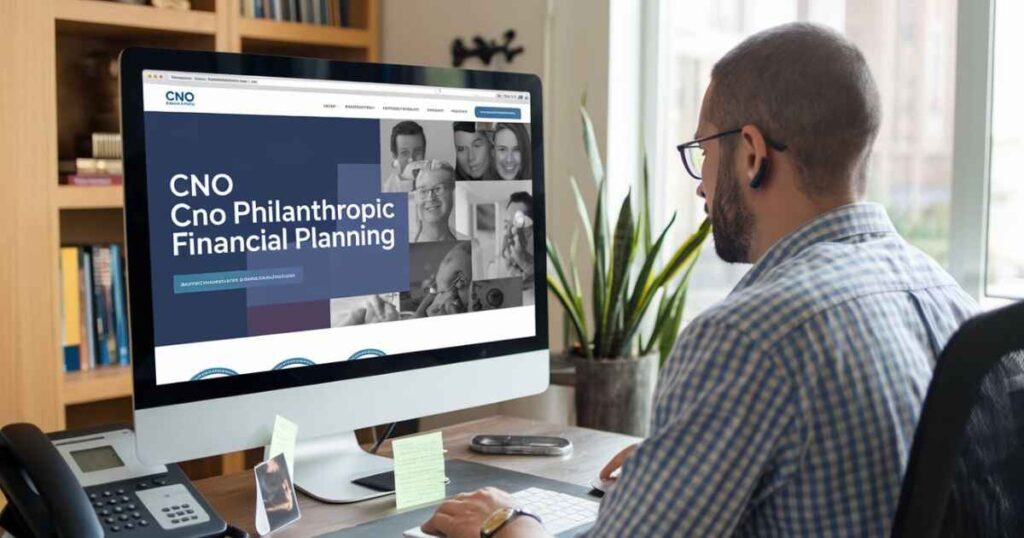In today’s world, the desire to make a positive impact is stronger than ever. Enter CNO philanthropic financial planning a game-changer for those who want to give back without breaking the bank.
This approach isn’t just for the mega-rich; it’s a smart strategy for anyone looking to align their financial goals with their charitable aspirations.
Let’s dive into this fascinating world and discover how you can become a savvy philanthropist while securing your financial future.
Introduction: The Art of Giving Smartly
Imagine being able to support causes close to your heart while also growing your wealth. Sounds too good to be true? Well, that’s the magic of CNO philanthropic financial planning. It’s like hitting two birds with one stone you get to be generous and financially savvy at the same time.
This approach is gaining traction in the USA, and for good reason. It’s not just about writing checks; it’s about creating a lasting impact while ensuring your own financial stability. Whether you’re a seasoned philanthropist or just dipping your toes into the world of giving, this guide will show you how to make the most of your charitable efforts.
What is CNO Philanthropic Financial Planning?

At its core, CNO philanthropic financial planning is a strategic approach to managing your wealth with a dual focus: personal financial stability and meaningful charitable giving. It’s like creating a roadmap that leads to both financial success and social impact.
This isn’t your grandpa’s way of giving. It’s a modern, thoughtful approach that considers your financial health, personal values, and the causes you’re passionate about. The goal? To create a win-win situation where your giving makes a real difference without compromising your financial future.
Why is CNO Philanthropic Financial Planning Important?
In a world where social issues are becoming increasingly complex, strategic giving has never been more crucial. CNO philanthropic financial planning allows you to maximize your impact while ensuring your own financial security.
It’s like being the captain of a ship you’re steering your resources towards causes you care about while keeping an eye on your financial horizon.
This approach is important for several reasons:
- It amplifies your social impact
- It ensures your financial stability
- It offers tax advantages
- It helps build a lasting legacy
- For businesses, it enhances corporate social responsibility efforts
By adopting CNO philanthropic financial planning, you’re not just throwing money at problems; you’re investing in solutions while safeguarding your financial future.
Key Benefits of CNO Philanthropic Financial Planning
1. Tax Deductions: The Gift That Keeps on Giving
One of the most appealing aspects of CNO philanthropic financial planning is the potential for significant tax benefits. It’s like the government is giving you a pat on the back for your generosity. By strategically planning your charitable giving, you can potentially lower your taxable income, resulting in substantial savings.
For example, if you’re in the 24% tax bracket and donate $10,000 to qualified charities, you could save $2,400 on your taxes. That’s money that can be reinvested or used for additional giving. It’s a win-win situation that makes philanthropy more accessible and rewarding.
2. Aligning Donations with Personal or Corporate Values
CNO philanthropic financial planning allows you to put your money where your heart is. It’s about more than just giving; it’s about making a statement with your resources. By aligning your donations with your personal or corporate values, you create a deeper connection to your philanthropic efforts.
For individuals, this might mean supporting education initiatives if you believe in the power of learning. For businesses, it could involve backing environmental causes if sustainability is a core company value. This alignment not only amplifies your impact but also brings a sense of fulfillment and purpose to your giving.
3. Structured and Sustainable Giving
Gone are the days of haphazard, sporadic donations. CNO philanthropic financial planning introduces structure and sustainability to your giving. It’s like creating a budget for your household, but instead, you’re budgeting for good deeds.
This structured approach ensures that your giving is consistent and impactful over time. It allows you to make larger, more meaningful contributions to causes you care about, rather than small, scattered donations that might not move the needle.
4. Improved Public Image and Employee Engagement
For businesses, CNO philanthropic financial planning can be a powerful tool for enhancing public image and boosting employee morale. It’s like killing two birds with one stone – you’re doing good in the world while also strengthening your brand and team.
Companies that engage in strategic philanthropy often see improved customer loyalty and increased employee satisfaction. It’s not just about writing checks; it’s about creating a culture of giving that resonates with both customers and employees.
5. Creating a Lasting Legacy
Perhaps one of the most profound benefits of CNO philanthropic financial planning is the opportunity to create a lasting legacy. It’s about making an impact that outlives you, leaving the world a little better than you found it.
Through tools like charitable trusts or foundations, you can ensure that your philanthropic efforts continue long after you’re gone. It’s a way to extend your values and passions into the future, creating a ripple effect of positive change for generations to come.
Also Read: The Muppet with the Long Hooked Beak: A Quirky Icon’s Journey
How CNO Philanthropic Financial Planning Works?

1. Assess Your Financial Situation
The journey of CNO philanthropic financial planning begins with a clear understanding of your financial landscape. It’s like taking stock of your pantry before planning a feast – you need to know what you’re working with.
This step involves a comprehensive review of your assets, income, liabilities, and future financial goals. By gaining a clear picture of your financial health, you can determine how much you can realistically allocate to charitable giving without compromising your financial security.
2. Identify Causes You Care About
Once you’ve got a handle on your finances, it’s time to soul-search and identify the causes that truly resonate with you. This is the heart of philanthropic planning – aligning your giving with your passions and values.
Take some time to research different charitable organizations and their impact. Look for causes that not only tug at your heartstrings but also align with your long-term vision for change. Remember, effective philanthropy is about more than just feeling good; it’s about making a tangible difference.
3. Set a Budget for Giving
With your finances assessed and causes identified, it’s time to crunch some numbers. Setting a budget for giving is crucial in CNO philanthropic financial planning. It’s about finding that sweet spot between generosity and financial prudence.
Consider using the concept of “stretch giving” – setting a giving goal that pushes you slightly out of your comfort zone but remains achievable. This approach can help you maximize your impact while still maintaining financial stability.
4. Choose the Right Philanthropic Strategy
CNO philanthropic financial planning offers a variety of strategies to choose from. It’s like having a toolbox full of different instruments – you need to select the right ones for the job at hand.
Some popular strategies include:
- Donor-Advised Funds (DAFs)
- Charitable Trusts
- Direct Giving
- Endowments
Each strategy has its own set of pros and cons. The key is to choose the approach that best aligns with your financial situation, giving goals, and desired level of involvement.
5. Consult with a Financial Planner
Navigating the world of philanthropic financial planning can be complex. That’s where a financial planner comes in. Think of them as your personal philanthropic coach, guiding you through the intricacies of strategic giving.
A good financial planner can help you:
- Optimize your giving for tax efficiency
- Balance charitable contributions with other financial goals
- Stay updated on changing tax laws and regulations
- Evaluate the impact of your giving
When choosing a financial planner, look for someone with experience in philanthropic planning and a track record of helping clients achieve their giving goals.
6. Monitor and Adjust Your Plan
CNO philanthropic financial planning isn’t a set-it-and-forget-it endeavor. It requires regular monitoring and adjustment to ensure it remains aligned with your goals and circumstances.
Set aside time each year to review your giving plan. Assess the impact of your donations, consider any changes in your financial situation, and make adjustments as needed. Remember, flexibility is key in maintaining a sustainable and effective giving strategy.
4 Steps To Create A Charitable Giving Plan
Creating a charitable giving plan doesn’t have to be overwhelming. Here’s a simple 4-step process to get you started:
- Define Your Giving Goals: What do you want to achieve through your philanthropy?
- Assess Your Resources: How much can you realistically give?
- Research and Select Charities: Which organizations align with your goals and use donations effectively?
- Implement and Review: Put your plan into action and regularly assess its effectiveness.
Remember, the key to successful charitable giving is consistency and intentionality. Start small if you need to, and grow your giving over time as you become more comfortable with the process.
Consider These Charitable Giving Strategies
Donor-Advised Funds (DAFs)
Donor-Advised Funds are like charitable savings accounts. You contribute money or assets to the fund, receive an immediate tax deduction, and then recommend grants to charities over time.
Pros:
- Immediate tax deduction
- Ability to grow donations tax-free
- Flexibility in timing of charitable grants
Cons:
- Loss of direct control over assets
- Potential fees
DAFs are great for those who want to make a large charitable contribution now but distribute the funds over time.
Qualified Charitable Distributions (QCDs)
For those over 70½, Qualified Charitable Distributions allow you to donate directly from your IRA to a charity. This can satisfy your Required Minimum Distribution (RMD) while reducing your taxable income.
Key Points:
- Must be 70½ or older
- Up to $100,000 per year
- Donation goes directly to the charity
QCDs are an excellent strategy for retirees looking to minimize their tax burden while supporting their favorite causes.
Leveraging Retirement Accounts
Your retirement accounts can be powerful tools for charitable giving. By naming a charity as a beneficiary of your IRA or 401(k), you can leave a significant legacy while potentially reducing the tax burden on your heirs.
Benefits:
- Avoid income taxes on distributions
- Reduce estate taxes
- Support your favorite causes
This strategy is particularly effective for those with substantial retirement savings who want to leave a charitable legacy.
Donating Appreciated Assets
Instead of selling appreciated assets and donating the proceeds, consider donating the assets directly to charity. This strategy can help you avoid capital gains taxes while still receiving a charitable deduction.
Example: Let’s say you have stock that’s worth $10,000 but you only paid $2,000 for it. If you sell it and donate the cash, you’ll owe capital gains tax on the $8,000 profit. But if you donate the stock directly, you avoid the capital gains tax and still get a $10,000 charitable deduction.
Set Up Automatic Monthly Donations
Sometimes, the simplest strategies are the most effective. Setting up automatic monthly donations can help you consistently support your favorite causes without having to think about it.
Benefits:
- Easier budgeting
- Consistent support for charities
- Potential for increased giving over time
This strategy is great for those who want to make giving a regular part of their financial routine.
Essential Elements of CNO Charitable Wealth Management

Effective CNO charitable wealth management involves several key elements:
- Clear Goals: Define what you want to achieve through your philanthropy.
- Integrated Planning: Align your charitable giving with your overall financial plan.
- Tax Efficiency: Maximize the tax benefits of your charitable contributions.
- Impact Measurement: Regularly assess the effectiveness of your giving.
- Flexibility: Be prepared to adjust your strategy as circumstances change.
By incorporating these elements into your philanthropic financial plan, you can ensure that your giving is both impactful and sustainable.
Setting Up a Budget for Donations to Charities
Creating a budget for charitable donations is a crucial step in CNO philanthropic financial planning. Here’s a simple process to get you started:
- Assess Your Income: Determine how much you can afford to give.
- Set a Giving Goal: Decide on a percentage of your income to donate.
- Prioritize Causes: Allocate your giving budget among your chosen causes.
- Consider Timing: Decide whether to give monthly, quarterly, or annually.
- Review and Adjust: Regularly reassess your giving budget based on your financial situation.
Remember, the goal is to create a sustainable giving plan that aligns with your financial goals and charitable aspirations.
Also Read: Unleash Your Football Frenzy: Discover Retro Bowl Unblocked Games 66
Planning for Legacy
Legacy planning is about ensuring your philanthropic efforts continue beyond your lifetime. It’s a way to extend your impact and values into the future.
Key Strategies for Legacy Planning:
- Establish a private foundation
- Create a charitable trust
- Name charities as beneficiaries in your will or retirement accounts
- Set up a donor-advised fund with succession plans
By incorporating philanthropy into your estate planning, you can create a lasting legacy of giving that benefits future generations.
Hazard Assessment in CNO Philanthropic Financial Planning
While CNO philanthropic financial planning offers numerous benefits, it’s important to be aware of potential risks:
- Over-committing Financially: Giving beyond your means can jeopardize your financial security.
- Tax Law Changes: Shifts in tax policy can impact the benefits of certain giving strategies.
- Charity Mismanagement: Poor management by charitable organizations can diminish the impact of your donations.
- Market Fluctuations: Economic downturns can affect the value of donated assets.
To mitigate these risks, diversify your giving, stay informed about tax laws, thoroughly research charities, and maintain a flexible giving strategy.
Techniques for Planning CNO Charitable Wealth Effectively
Effective CNO charitable wealth planning requires a comprehensive approach:
- Set Clear Objectives: Define your philanthropic goals and priorities.
- Integrate with Overall Financial Plan: Ensure your giving aligns with your broader financial strategy.
- Leverage Professional Expertise: Work with financial advisors, tax professionals, and philanthropy experts.
- Stay Informed: Keep up with changes in tax laws and charitable giving trends.
- Regular Review: Assess and adjust your plan periodically to ensure it remains effective and aligned with your goals.
By employing these techniques, you can maximize the impact of your giving while maintaining financial stability.
Chief Nursing Officer’s Function in Charitable Wealth Planning
For Chief Nursing Officers (CNOs), philanthropic financial planning can play a unique role. CNOs can leverage their healthcare expertise to inform their giving strategies, potentially focusing on health-related causes or organizations.
Key Considerations for CNOs:
- Align giving with healthcare industry insights
- Support initiatives that complement professional goals
- Balance charitable giving with career advancement and personal financial planning
By integrating their professional knowledge with their philanthropic efforts, CNOs can create a powerful synergy between their career and their charitable impact.
CNO Philanthropic Financial Planning’s Advantages
The advantages of CNO philanthropic financial planning are numerous:
- Tax Benefits: Potential for significant tax deductions and savings
- Strategic Impact: Ability to make a more significant difference through focused giving
- Personal Fulfillment: Alignment of financial goals with personal values
- Legacy Creation: Opportunity to leave a lasting positive impact
- Financial Security: Balance between giving and personal financial stability
By adopting this approach, you can transform your charitable giving from a sporadic activity into a strategic part of your overall financial plan.
Common Mistakes in CNO Philanthropic Financial Planning
Even with the best intentions, it’s easy to make mistakes in philanthropic planning. Here are some common pitfalls to avoid:
- Giving Without a Plan: Donating impulsively without considering long-term impact
- Ignoring Tax Implications: Failing to optimize donations for tax efficiency
- Over-committing Financially: Pledging more than you can afford to give
- Neglecting Due Diligence: Not thoroughly researching charities before donating
- Failing to Review and Adjust: Sticking to a giving plan even when circumstances change
By being aware of these potential mistakes, you can create a more effective and sustainable philanthropic strategy.
Obstacles in CNO Charitable Wealth Management
Charitable wealth management can present several challenges:
- Balancing Multiple Financial Goals: Juggling charitable giving with other financial priorities
- Navigating Complex Tax Laws: Staying compliant while maximizing tax benefits
- Measuring Impact: Assessing the effectiveness of your charitable contributions
- Market Volatility: Managing the impact of economic fluctuations on your giving capacity
- Family Dynamics: Aligning philanthropic goals within a family or business
Overcoming these obstacles often requires patience, flexibility, and professional guidance.
Ethics in CNO Charitable Wealth Planning: A Consideration

Ethical considerations are paramount in philanthropic financial planning. Key ethical issues to consider include:
- Transparency: Being open about your giving motivations and methods
- Accountability: Ensuring donations are used effectively by recipient organizations
- Conflict of Interest: Avoiding personal gain from charitable activities
- Cultural Sensitivity: Respecting diverse perspectives in global giving
By maintaining high ethical standards, you can ensure your philanthropic efforts truly benefit society and align with your personal values.
Conclusion
CNO philanthropic financial planning emerges as a powerful strategy for individuals and organizations to make a meaningful impact while maintaining financial stability. This approach combines strategic giving with smart financial management, offering benefits such as tax advantages, alignment with personal values, and the creation of a lasting legacy.
By following a structured process from assessing one’s financial situation to implementing and regularly reviewing a giving plan – individuals can maximize their charitable impact. While challenges exist, including potential financial risks and ethical considerations, the rewards of strategic philanthropy are significant.
Ultimately, CNO philanthropic financial planning provides a framework for turning charitable aspirations into tangible, sustainable actions that benefit both the giver and society at large.
Frequently Asked Questions
How much money does CNO Financial Group have in total assets?
As of the most recent available data, CNO Financial Group had approximately $34 billion in total assets.
Who is the chief financial officer of CNO?
Paul H. McDonough is currently serving as the Chief Financial Officer of CNO Financial Group.
What is Conseco called now?
Conseco is now called CNO Financial Group. The company changed its name from Conseco to CNO Financial Group in 2010.
Who is the CEO of CNO Financial Group?
Gary C. Bhojwani is currently serving as the Chief Executive Officer of CNO Financial Group.
Where is CNO Financial Group located?
CNO Financial Group is headquartered in Carmel, Indiana, United States.










